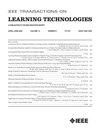使用数字化平台评估自闭症儿童和发育正常儿童执行图形的运动学和动力学属性
IF 2.9
3区 教育学
Q2 COMPUTER SCIENCE, INTERDISCIPLINARY APPLICATIONS
引用次数: 0
摘要
完整的图形执行能力被认为是一个人学业成功的重要标志。经常有报道称,神经畸形儿童和自闭症儿童(即患有自闭症谱系障碍(ASD)的儿童)的图形执行能力存在差异。虽然这些报告很有见地,但大多是针对与语言无关的文字手写任务(观察结果与书写者的语言技能有关),因此强调了在与语言无关的图形任务中评估图形执行能力的重要性。评估可以从运动属性(如笔杆的握力、手握笔的操作等)和运动属性(如笔尖的速度、笔尖的压力等)两方面进行。鉴于评估图形执行能力和使用语言无关平台的重要性,我们在研究中设计了一个语言无关的数字化平台,可以评估图形执行能力的运动学和动力学属性。我们将形状绘制(不同的转弯)作为图形任务。此外,我们还对 25 名神经畸形儿童和 25 名患有自闭症的儿童进行了研究。结果表明,无论绘制的是什么形状,两组参与者在图形执行的运动学和动力学属性上都存在差异。我们的系统可以帮助教师、治疗师等评估儿童的图形执行能力,并针对儿童面临的困难(如有)及时采取相应的策略。本文章由计算机程序翻译,如有差异,请以英文原文为准。
Assessment of Kinematic and Kinetic Attributes of Graphic Execution of Children With Autism and Typically Developing Children Using a Digitized Platform
Intact graphic execution ability is considered an important gateway to one's academic success. It is often reported that the graphic execution ability of neurotypical children and those having autism, i.e., children with autism spectrum disorder (ASD) is differentiated. Although insightful, these reports had been mostly for text handwriting task that is not language agnostic (with observations related to a writer's language skills), thereby emphasizing the importance of assessing graphic execution ability during language-agnostic graphic task. The assessment can be carried out in terms of kinetic (e.g., grip force exerted on the pen barrel, in-hand manipulation of the pen, etc.) and kinematic (e.g., speed of the pen-tip, pen-tip pressure, etc.) attributes. Given the importance of assessing one's graphic execution ability and the use of language-agnostic platform, in our study, we present the design of a language-agnostic digitized platform that can assess the kinematic and kinetic attributes of one's graphic execution ability. We included shape drawing (with varying turns) as the graphic task. Also, we carried out a study in which 25 neurotypical children and 25 children with ASD took part. Results indicated that, irrespective of the shape being drawn, the kinematic and kinetic attributes of graphic execution were differentiated between the two participant groups. Our system has the potential to help teachers, therapists, etc., to assess one's graphic execution ability and adopt timely strategies addressing the difficulties (if any) faced by a child.
求助全文
通过发布文献求助,成功后即可免费获取论文全文。
去求助
来源期刊

IEEE Transactions on Learning Technologies
COMPUTER SCIENCE, INTERDISCIPLINARY APPLICATIONS-
CiteScore
7.50
自引率
5.40%
发文量
82
审稿时长
>12 weeks
期刊介绍:
The IEEE Transactions on Learning Technologies covers all advances in learning technologies and their applications, including but not limited to the following topics: innovative online learning systems; intelligent tutors; educational games; simulation systems for education and training; collaborative learning tools; learning with mobile devices; wearable devices and interfaces for learning; personalized and adaptive learning systems; tools for formative and summative assessment; tools for learning analytics and educational data mining; ontologies for learning systems; standards and web services that support learning; authoring tools for learning materials; computer support for peer tutoring; learning via computer-mediated inquiry, field, and lab work; social learning techniques; social networks and infrastructures for learning and knowledge sharing; and creation and management of learning objects.
 求助内容:
求助内容: 应助结果提醒方式:
应助结果提醒方式:


